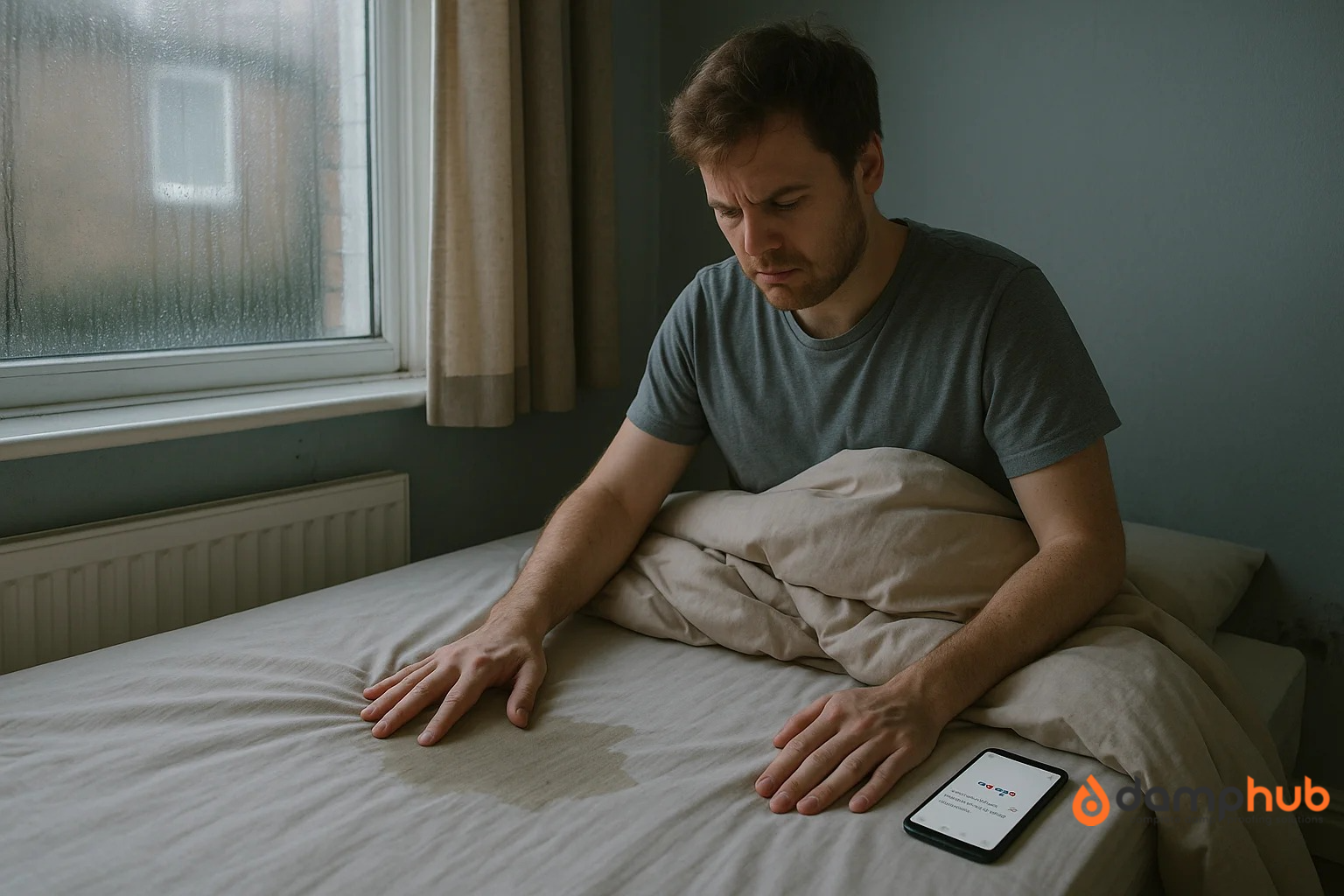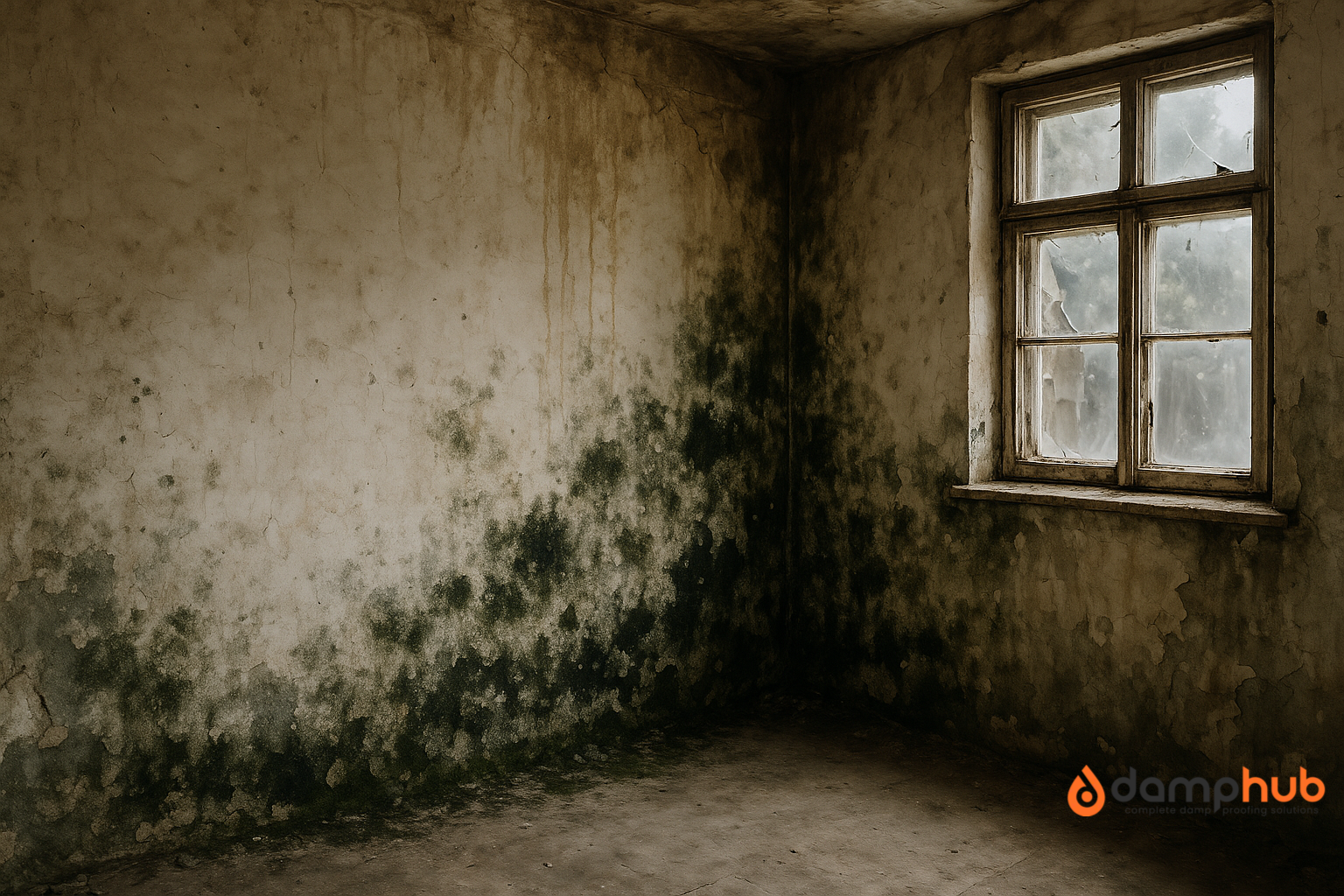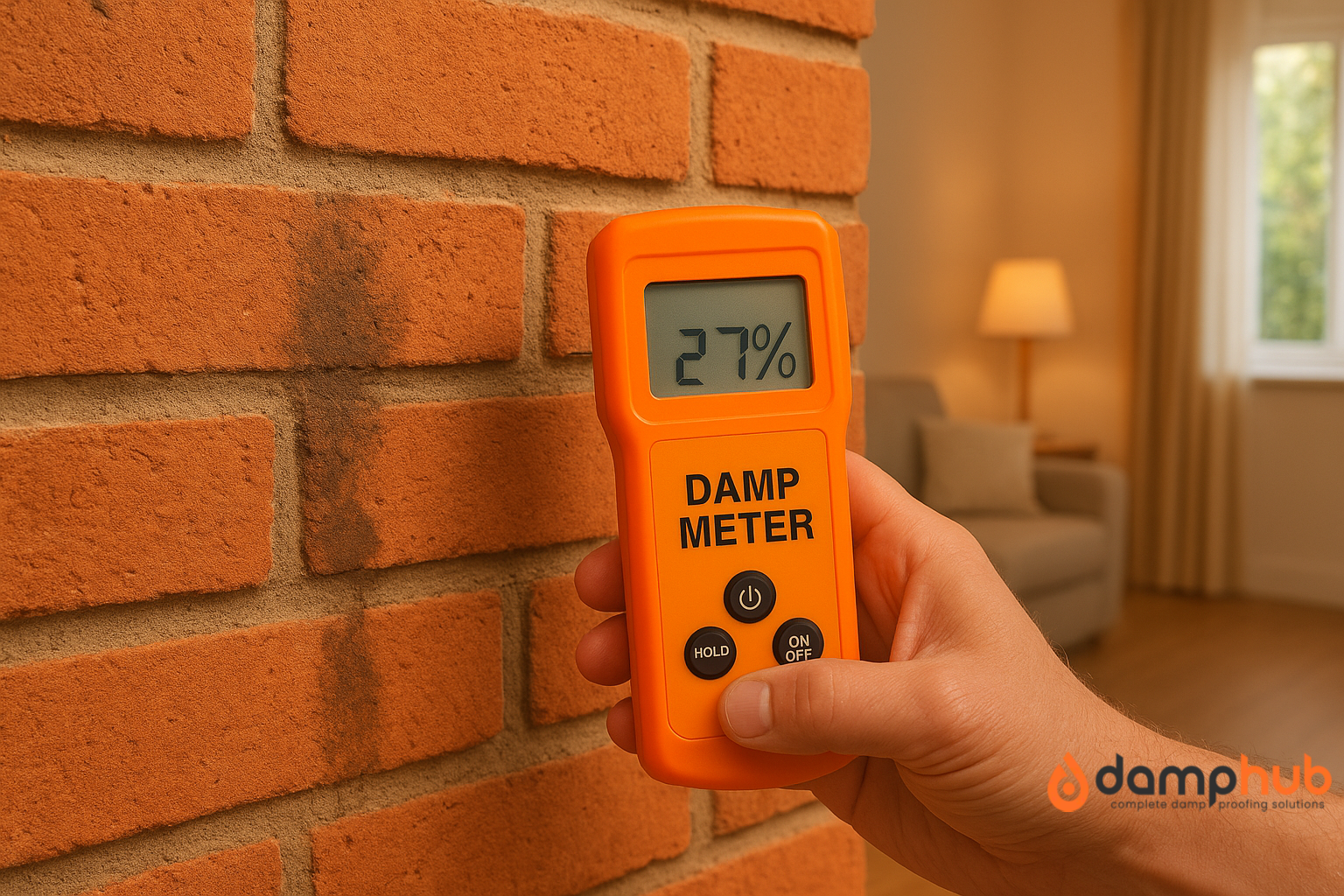
Waking up to find your bed sheets feeling damp can be both disconcerting and uncomfortable.
Beyond disrupting your sleep, it may also indicate underlying issues that affect your health, hygiene, or even the structural integrity of your home.
A clammy mattress isn’t always the result of obvious spills or perspiration; more often, it’s the outcome of a combination of environmental, structural, and behavioural factors.
This guide explores the most common causes behind a damp-feeling bed, from the quality of indoor air to the placement of your mattress.
It also examines how your body and daily habits might be contributing.
By the end, you’ll be equipped to distinguish between normal moisture and signs that point to a larger concern.
You’ll also find practical advice on how to dry your bed efficiently and prevent future recurrence.
👉 Must read: What is Damp – A Complete Guide 2025
Why Does My Bedding Feel Damp?
Below, we’ll explore some of the most common reasons your bedding might feel damp, helping you pinpoint the cause and find the right solution.
Top 10 Reasons Your Bed Feels Damp in the Morning
I. Environmental Causes of Damp Beds
A. Indoor Humidity and Weather Conditions
Humidity is a leading contributor to damp bedding.
When indoor relative humidity exceeds 50%, fabrics can begin to feel clammy, particularly overnight.
Seasonal transitions, such as spring and autumn, often bring sudden humidity fluctuations that are not always offset by adequate ventilation.
In regions that experience warm days followed by cool nights, rapid temperature changes can cause condensation to form on surfaces, including bedding.
As warm air cools, moisture condenses and settles into porous materials like mattresses and sheets.
B. Ventilation Deficiencies
Insufficient ventilation allows moisture to accumulate in enclosed spaces.
Without adequate airflow, the warm, humid air produced by respiration and body heat becomes trapped.
Over time, this can saturate soft furnishings, especially in rooms with limited window access or poor cross-ventilation.
Room orientation plays a role as well.
Bedrooms with shaded or north-facing windows may struggle to regulate humidity levels, making basic measures like opening a window or using a fan ineffective, particularly in wetter seasons.

C. Condensation and Cold Surfaces
Condensation occurs when warm, moist air encounters a cold surface.
During sleep, your body heats the bedding.
If your mattress is placed directly on a cold floor or against an external wall, this temperature disparity can result in condensation forming underneath or around the bed.
This is particularly common in winter months or in homes lacking sufficient insulation.
Moisture trapped between cold surfaces and bedding materials can lead to a persistently damp sensation by morning.
II. Structural or Building-Related Causes
A. Leaks and Water Intrusion
In some cases, the source of moisture lies hidden within the building.
Leaking pipes, roof damage, or poorly sealed windows can allow water to seep into bedrooms.
These issues often manifest as damp spots near the bed, peeling paint, or persistent musty odours.
Even minor leaks can allow moisture to build up over time, saturating adjacent furniture and bedding.
Older homes are particularly susceptible to slow pipe condensation within wall or ceiling cavities.

B. Poor Insulation or Flooring
Uninsulated floors can lead to condensation build-up beneath mattresses, especially when there’s no airflow between the bed and the floor.
Solid bases or foam platforms that sit directly on cold flooring trap moisture, leaving it nowhere to escape.
Basement bedrooms are especially vulnerable.
Rising damp, coupled with the consistently cool temperatures of underground rooms, can create a persistently humid sleeping environment.
III. Human and Biological Causes
A. Night Sweats and Thermoregulation
The human body naturally sweats during sleep, particularly during REM cycles.
This helps regulate core temperature, but when moisture isn’t able to evaporate effectively, it can leave bedding feeling uncomfortably damp.
Certain health conditions—including hormonal imbalances, infections, menopause, and anxiety—can lead to night sweats.
In such cases, room temperature alone may not be enough to prevent a moist sleeping environment.
B. Body Heat and Bedding Interaction
Bedding materials significantly impact moisture management.
Synthetic fabrics tend to trap heat, creating a microclimate that retains sweat and body heat.
This can result in a humid, sticky sleeping experience.
By contrast, natural fibres like cotton, bamboo, and Tencel wick moisture away more efficiently.
Polyester and memory foam, while common, are less breathable and may contribute to retained moisture.
C. Shared Sleeping Arrangements
Sharing a bed amplifies the amount of heat and humidity present.
Partners and pets contribute additional warmth, which may make the bed feel damp, especially if one person is a heavy sweater.
Sometimes, only one side of the bed is affected, depending on sleeping patterns and bedding distribution.
IV. Lifestyle and Bedding Hygiene Habits
A. Improperly Dried Bedding
Laundry practices can play a surprisingly large role.
Bedding that hasn’t been thoroughly dried after washing can retain residual moisture.
Thick items—like mattress protectors or duvets—may feel dry on the surface but still hold dampness within.
Even folding and storing sheets before they’re fully dry can trap moisture, causing them to smell musty or feel wet when used.
B. Infrequent Mattress Maintenance
Mattresses gradually absorb sweat and humidity.
Without regular airing or rotation, moisture accumulates within.
Foam and hybrid mattresses are particularly prone to this, as their dense materials retain dampness.
Over time, this can lead to mildew or mould forming inside the mattress, especially if it’s never exposed to direct sunlight or fresh air.
C. Beverage Spills and Hidden Damp
Spills from water, tea, or other drinks might dry on the surface but leave deeper layers saturated.
These hidden damp spots often go unnoticed until they produce odours, staining, or microbial growth.

V. Damp Detection and Early Warning Signs
Recognising the early signs of damp can help you act before more serious problems develop.
Watch for:
- Musty or sour odours
- Cold or clammy fabric textures
- Yellow or brown stains on bedding or mattress surfaces
Respiratory issues or allergy flare-ups during the night can also indicate elevated humidity, mould growth, or dust mites.
Visibly dark spots or mildew on fabrics are clear signs that moisture has persisted for some time.
A quick check under the mattress or along exterior walls may reveal trapped moisture before it becomes a widespread problem.
VI. How to Identify the Cause of Bed Dampness
Before jumping to solutions, it’s important to figure out what’s actually causing the damp feeling in your bed.
This means looking closely at your sleeping environment, observing patterns, and using basic tools to help rule things in or out.
Below are steps to help you gather evidence, along with what each finding might indicate.
👉 Must read: How to Remove Damp from Walls: The Ultimate Guide
A. Monitor When the Dampness Appears
Start by paying attention to when your bed feels damp.
- If the bed only feels damp in the morning, the moisture is likely coming from your body—sweat, breath, or body heat trapped under heavy bedding.
- If the dampness is present even before bedtime, you may be dealing with high room humidity, poor ventilation, or hidden moisture in the mattress itself.
- If it coincides with rainy or humid weather, that points to environmental humidity or structural issues like poor insulation or moisture intrusion from outside.
Write down your observations over several nights.
This helps clarify whether the source is internal (body or bedding) or external (room or structure).
B. Track Room Humidity Levels
Use a hygrometer to record indoor humidity levels, especially during the night and early morning.
- If readings are consistently above 60% overnight, the room likely has excess humidity in the air, which can condense into bedding materials.
- If humidity spikes in one room but not others, you may be dealing with room-specific issues like poor airflow, a cold wall, or rising damp.
- If humidity stays under 50% and the bed still feels damp, body sweat or mattress construction may be the cause, not the room.
Take readings with the door closed and heating off to reflect true overnight conditions.
C. Check for Localised Moisture Around the Bed
Physically inspect the mattress, bed frame, and nearby surfaces.
- If one area of the mattress is damper than the rest, that suggests localised sweating or possibly a spill.
- If the underside of the mattress or the area near the floor feels cooler and moist, the issue may be condensation from a cold surface, especially if the mattress sits directly on solid flooring or an exterior wall.
- If a paper towel or cloth left under the mattress comes out damp, this points to rising moisture from below, possibly due to poor ventilation or floor insulation.
These checks help confirm whether moisture is building up inside the bed or coming from surrounding structures.
D. Observe How Bedding Materials React
Different materials behave differently when exposed to moisture.
- If natural fabrics like cotton or bamboo feel damp while synthetics stay dry, your bedding might be absorbing too much body moisture without drying properly.
- If pillows or sheets develop a musty smell, especially in humid corners, that suggests persistent damp rather than a one-off event.
- If only one side of the bed feels clammy, it could be due to an individual sleeper’s sweat levels or airflow blocked by wall proximity.
Tracking how and where different bedding materials are affected helps narrow down whether you’re dealing with retained sweat, poor airflow, or fabric that traps moisture.
E. Look for Structural Clues Around the Bedroom
Don’t forget to inspect the room itself.
- If you see water stains, peeling paint, or mould spots on nearby walls or ceilings, a leak or water ingress could be contributing.
- If floors are cold to the touch or smell damp, rising moisture from below may be affecting the mattress, especially in basement rooms or those with solid flooring and no airflow underneath.
- If dampness increases near windows, condensation or poor window sealing may be the source.
These visual checks give you early warning signs of building-related issues that could affect your sleeping environment without being directly visible on the bed itself.
👉 Must read: How to Treat Damp Walls Internally: A Step-by-Step Guide

VII. How to Dry a Damp Bed Properly
A. Immediate Remedies
Begin by stripping all bedding. Use clean, dry towels to blot surface moisture.
A hair dryer on a cool or low-heat setting can be used for small areas.
Position a fan nearby to accelerate air circulation.
If the mattress is affected, rotate or stand it upright and allow airflow around it.
This is especially effective when combined with a heater or dehumidifier.

B. Utilising Sunlight and Dehumidifiers
Sunlight is a natural antibacterial agent and moisture eliminator.
On sunny days, take advantage by airing out sheets and pillows outdoors.
In colder or wetter seasons, use a dehumidifier in the bedroom.
It will extract excess moisture from both the air and the surrounding soft materials.
A space heater can help warm the room during the drying process, but avoid direct heat on foam materials.

VIII. Preventing Bed Dampness Long-Term
A. Enhance Air Circulation
Daily ventilation is key. Open windows to allow fresh air in and stale, moist air out.
Where natural cross-breezes aren’t possible, use ceiling or exhaust fans to maintain airflow.
Be sure to ventilate wardrobes and storage areas as well, as they can harbour trapped humidity that eventually spreads into the room.

B. Choose Breathable Materials
Opt for breathable fabrics like cotton, bamboo, or moisture-wicking Tencel in your bedding.
These materials improve airflow and reduce moisture retention.
When selecting mattress protectors or toppers, avoid those with non-breathable plastic backing unless they feature moisture-permeable membranes.
C. Improve Bedroom Layout
Avoid placing beds flush against external walls.
A 10 cm buffer allows air to circulate and reduces the chance of cold-surface condensation.
Use slatted bed bases that allow air to move underneath the mattress.
Regularly rotate and flip the mattress, and allow it to air out in sunlight when possible.
D. Incorporate Technology
Install a digital hygrometer to monitor indoor humidity levels.
Smart humidity sensors can alert you when thresholds are exceeded.
Consider dehumidifiers with timers or smart HVAC systems that offer moisture control for consistent air quality.
👉 Also read: How to Get Rid of a Damp Smell
IX. When to Seek Professional Help
If bedding dampness persists despite changes in bedding, ventilation, and cleaning routines, professional assessment may be necessary.
Hidden leaks, rising damp, or insufficient insulation could be at play.
Look out for:
- Recurring mould patches on walls or ceilings
- Persistent damp spots near furniture
- Moisture returning shortly after drying
A licensed building inspector or damp surveyor can evaluate the space, identify the root cause, and recommend appropriate structural or waterproofing solutions.

Conclusion
A damp-feeling bed is more than a minor inconvenience—it can signal broader issues within your home environment or sleeping habits.
Factors ranging from indoor humidity and insulation gaps to biological processes and bedding materials all play a role.
Fortunately, most causes are manageable.
With the right combination of ventilation, bedding choice, and routine maintenance, you can restore a dry, healthy sleeping environment.
Remain attentive to early signs, take action when needed, and don’t hesitate to consult a professional if the issue remains unresolved.
A dry bed isn’t just about comfort—it’s a key component of good health and restorative sleep.
FAQs
What can I put under my mattress for moisture?
A coir bed rug (made from coconut fibre) or a moisture barrier works well.
These create a breathable layer between your mattress and base, helping air circulate and stopping condensation from forming underneath.
How to stop mould from growing under a bed?
Keep the space under your bed clear and dry.
Raise the mattress if it’s on the floor, use slats or breathable layers, and let air circulate regularly.
Running a dehumidifier or opening windows can also help control moisture in the room.
Why shouldn’t you sleep in a damp bed?
Because it’s not just uncomfortable—it’s unhealthy.
A damp bed encourages mould, bacteria, and dust mites, which can trigger allergies, skin irritation, and breathing problems over time.
Why does my bedding feel damp at night?
It’s usually caused by a mix of body heat, sweat, and poor airflow.
If your mattress is on a solid base or the room is humid, moisture gets trapped and builds up, making the bed feel clammy.
How can I make my house less damp?
Ventilate daily, especially in the kitchen and bathroom.
Fix any leaks, avoid drying clothes indoors, and keep furniture away from cold walls.
A dehumidifier can also make a big difference.
Can a damp bedroom cause health problems?
Yes.
Damp air can lead to mould growth, which may trigger coughing, wheezing, sinus issues, or worsen asthma, especially for kids or anyone with allergies.
How do I protect my bed from moisture?
Use a breathable mattress protector and keep your bed off the floor.
A slatted base or coir mat helps with airflow underneath.
Also, air out your bedding during the day to let moisture escape.
Does a mattress need to breathe underneath?
Definitely. Mattresses absorb moisture from your body overnight.
If air can’t circulate underneath, that moisture gets trapped, which can lead to mould or odours.
Why shouldn’t you make your bed first thing in the morning?
Because it traps moisture from the night before.
Leaving your bed open for 30 minutes lets sweat and heat escape, helping keep your bedding fresh and less inviting for dust mites.






